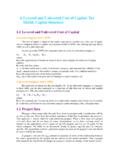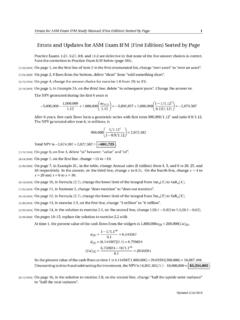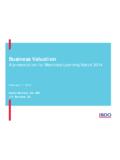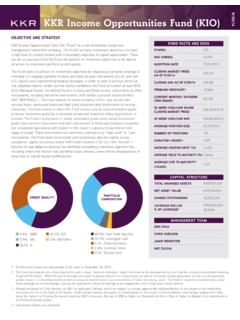Transcription of WP no 488 CIIF - iese.edu
1 IESE Business School-University of Navarra - 1 LEVERED AND unlevered BETA Pablo Fern ndez IESE Business School Universidad de Navarra Avda. Pearson, 21 08034 Barcelona, Espa a. Tel.: (+34) 93 253 42 00 Fax: (+34) 93 253 43 43 Camino del Cerro del guila, 3 (Ctra. de Castilla, km 5,180) 28023 Madrid, Espa a. Tel.: (+34) 91 357 08 09 Fax: (+34) 91 357 29 13 Copyright 2003 IESE Business School. Working PaperWP no 488 January, 2003 (Rev. May 2006) CIIF IESE Business School-University of Navarra The CIIF, International Center for Financial Research, is an interdisciplinary center with an international outlook and a focus on teaching and research in finance. It was created at the beginning of 1992 to channel the financial research interests of a multidisciplinary group of professors at IESE Business School and has established itself as a nucleus of study within the School s activities.
2 Ten years on, our chief objectives remain the same: Find answers to the questions that confront the owners and managers of finance companies and the financial directors of all kinds of companies in the performance of their duties Develop new tools for financial management Study in depth the changes that occur in the market and their effects on the financial dimension of business activity All of these activities are programmed and carried out with the support of our sponsoring companies. Apart from providing vital financial assistance, our sponsors also help to define the Center s research projects, ensuring their practical relevance. The companies in question, to which we reiterate our thanks, are: Aena, Kearney, Caja Madrid, Fundaci n Ram n Areces, Grupo Endesa, Royal Bank of Scotland and Uni n Fenosa. IESE Business School-University of Navarra LEVERED AND unlevered BETA Pablo Fern ndez* Abstract We claim that in a world without leverage cost the relationship between the levered beta ( L) and the unlevered beta ( u) of a company depends upon the financing strategy.
3 For a company that maintains a fixed book-value leverage ratio, the relationship is Fern ndez (2004): L = u + ( u d) D (1 T) / E. For a company that maintains a fixed market-value leverage ratio, the relationship is Miles and Ezzell (1980): L = u + (D / E) ( u d) [1 T Kd / (1 + Kd)]. For a company with a preset debt in every period, the relationship is Modigliani and Miller (1963): L = u + [ u d] (D-VTS) / E, where the Value of Tax Shields (VTS) is the present value of the future tax shields discounted at the cost of debt. We also analyze alternative valuation theories proposed in the literature to estimate the relationship between the levered beta and the unlevered beta (Harris and Pringle (1985), Damodaran (1994), Myers (1974), and practitioners) and prove that all provide inconsistent results. * Professor of Financial Management, PricewaterhouseCoopers Chair of Finance, IESE JEL Classification: G12, G31, M21 Keywords: unlevered beta, levered beta, asset beta, value of tax shields, required return to equity, leverage cost IESE Business School-University of Navarra LEVERED AND unlevered BETA This paper provides guidelines to evaluate the appropriateness of various relationships between the levered beta and the unlevered beta.
4 We develop valuation formulae for a company that maintains a fixed book-value leverage ratio and claim that this is more realistic than to assume, as Miles and Ezzell (1980) do, a fixed market-value leverage ratio. We prove that the relationship between the levered beta ( L), the unlevered beta ( u) and the beta of the debt ( d) in a world with no leverage cost for a company that maintains a fixed book-value leverage ratio is: [18] L = u + ( u d) D (1 T) / E In order to reach this result, we first prove that the value of tax shields (VTS) in a world with no leverage cost, for a constant growing company that maintains a fixed book-value leverage ratio, is the present value of the debt (D) times the tax rate (T) times the required return to the unlevered equity (Ku), discounted at the unlevered cost of equity (Ku): [12] VTS = D T Ku / (Ku g) Please note that this does not mean that the appropriate discount for tax shields is the unlevered cost of equity.
5 We discount D T Ku, which is higher than the tax shield. As shown in Fern ndez (2004), equation [12] is the difference of two present values. The paper is organized as follows. In Section 1, we derive the relationship between the levered beta and the unlevered beta for growing perpetuities that maintain a fixed book-value leverage ratio in a world without leverage costs. This relationship is equation [18]. In Section 2, we review the financial literature on the relationship between the levered beta and the unlevered beta. In Section 3 we analyze the seven theories for perpetuities. We prove that several theories provide inconsistent results: Harris-Pringle (1985), Miles-Ezzell (1980) Modigliani-Miller (1963), Myers (1974), and Practitioners. Our conclusions are in Section 4. Appendix 1 contains a list of symbols and abbreviations used in the paper, and Appendix 2, the main valuation formulas according to the seven valuation theories that we analyze.
6 2 - IESE Business School-University of Navarra 1. Relationship between the levered beta and the unlevered beta for growing perpetuities that maintain a fixed book-value leverage ratio in a world without leverage costs The formula for the adjusted present value [1] indicates that the value of the debt today (D) plus that of the equity (E) of the levered company is equal to the value of the unlevered company (Vu) plus the value of tax shields due to interest payments (VTS). [1] E + D = Vu + VTS It is useful to get the relationship between the required return to equity (Ke), the required return to unlevered equity (Ku), the required return to debt (Kd), E, D, VTS and g (growth) for growing perpetuities. E{ } is the expected value operator. As Vu = E{FCF} / (Ku g), we can rewrite equation [1] as [2] E + D = Vu = E{FCF} / (Ku g) + VTS In a growing perpetuity, the relationship between the expected equity cash flow (E{ECF}) and the expected free cash flow (E{FCF}) is [3] E{FCF} = E{ECF} + D Kd (1 T) g D By substituting [3] in [2], we get: [4] E + D = [ECF + D Kd (1 T) g D] / (Ku g) + VTS As the relationship between the equity cash flow and the equity value is ECF = E (Ke g) we may rewrite [4] as: [5] E + D = [E (Ke g) + D Kd (1 T) g D] / (Ku g) + VTS Multiplying both sides of equation [5] by (Ku g) we get: [6] (E + D) (Ku g) = [E (Ke g) + D Kd (1 T) g D] + VTS (Ku g) Eliminating g (E + D) on both sides of equation [6]: [7] (E + D) Ku = [E Ke + D Kd (1 T)] + VTS (Ku g) Equation [7] may be rewritten as.
7 [8] D [Ku Kd (1 T)] E (Ke Ku) = VTS (Ku g) Fern ndez (2006) proves in his equation (12) that the Value of tax shields is [9] [][] +==1t001t00 DPVTD TInterestPVTVTS Equation [9], valid for companies with any pattern of growth, shows that the value of tax shields depends only upon the nature of the stochastic process of the net increase of debt. The value today of the expected increases of debt depends on the financing strategy. If the company has a preset amount of debt, the future increases of debt ( Dt) are known with certainty today and Modigliani-Miller (1963) applies: the appropriate discount rate for Dt is RF, the risk-free rate. If the debt is expected to increase at a constant rate g, then PV0 [ Dt] = D0 IESE Business School-University of Navarra - 3 (1+g)t/(1+ RF)t and equation [9] is the sum of a geometric progression with growth rate (1+g)/(1+RF). Then: [10] g)(R TRDgRgDTTDVTSFF0F000 = += Fieten et al.
8 (2005) argue that the Modigliani-Miller formula may be applied to all situations. However, it is valid only when the company has a preset amount of debt. Miles and Ezzell (1980) and Arzac and Glosten (2005) assume that debt is proportional to equity market value in every period (Dt = L St). If Dt = L St, the appropriate discount rate for St is equal to the required return to the value of debt. As VTS is proportional to D, following equation [1], Dt, St, Vut and VTSt have the same risk and the appropriate discount rate for all of them is Ku, because the appropriate discount rate for Vut is Ku. Then, the value today of the increase of debt in period 1 is: []F0010R1 DKu1)g1(DDPV+ ++= The present value of the expected increase of debt in period t (as Dt-1 is known in period t-1) is: []1tF1t0tt0t0)Ku1)(R1()g1D)Ku1()g1(DDPV +++ ++= The sum of all the present values of the expected increases of debt is a geometric progression with growth rate = (1+g)/(1+Ku).
9 The sum is: [] + = =FF01tt0R1 RKug)gKu(DDPV Substituting the last equation in [9], we get the well known Miles-Ezzell formula: [11] )R(1Ku)(1g)(KuT RDVTSFF00++ = To assume Dt = L St is not a good description of the debt policy of any company because if a company has only two possible states of nature in the following period, under the worst state (low share price) the company will have to raise new equity and repay debt, and this is not the moment companies prefer to raise equity. Under the good state, the company will have to take on a lot of debt and pay big dividends. The Miles-Ezzell setup is equivalent to assuming that the increase of debt is proportional to the increase of the free cash flow in every period. Fern ndez (2006) shows that for a company with a fixed book-value leverage ratio, the increase of debt is proportional to the increases of net assets, and the risk of the increases of debt is equal to the risk of the increases of assets.
10 If Ku is the appropriate discount rate for the expected increases of the book value of assets, then: []gKugDDPV01tt0 = = (12) Substituting the last equation in [9], we get: 4 - IESE Business School-University of Navarra [12] VTS = D T Ku / (Ku g) Substituting equation [12] in [8], we get: [13] Ke = Ku + (D / E) (1 T) (Ku Kd) The formulas relating the betas to the required returns are: [14] Ke = RF + L PM [15] Ku = RF + u PM [16] Kd = RF + d PM RF is the risk-free rate and PM is the market risk premium. Substituting [14], [15] and [16] in [13], we get: [17] RF + L PM = RF + u PM + (RF + u PM RF d PM) D (1 T) /E Then, the relationship between the beta of the levered equity ( L), the beta of the unlevered equity ( u) and the beta of debt ( d) for a company with a fixed book-value leverage ratio in a world without leverage costs is: [18] L = u + ( u d) D (1 T) / E Equation [12], applied to the general case, is (see Fern ndez (2004)): [19] VTS = PV[Ku; D T Ku] 2.














